Transport Characteristics of Silicon Multi-Quantum-Dot Transistor Analyzed by Means of Experimental Parametrization Based on Single-Hole Tunneling Model
Abstract
1. Introduction
2. Experimental Section
3. Results and Discussion
4. Summary and Conclusions
Author Contributions
Funding
Institutional Review Board Statement
Informed Consent Statement
Data Availability Statement
Conflicts of Interest
References
- Patra, B.; Incandela, R.M.; van Dijk, J.P.G.; Homulle, H.A.R.; Song, L.; Shahmohammadi, M.; Staszewski, R.B.; Vladimirescu, A.; Babaie, M.; Sebastiano, F.; et al. Cryo-CMOS Circuits and Systems for Quantum Computing Applications. IEEE J. Solid State Circuits 2018, 53, 309–321. [Google Scholar] [CrossRef]
- Gonzalez-Zalba, M.F.; de Franceschi, S.; Charbon, E.; Meunier, T.; Vinet, M.; Dzurak, A.S. Scaling silicon-based quantum computing using CMOS technology. Nat. Electron. 2021, 4, 872–884. [Google Scholar] [CrossRef]
- Veldhorst, M.; Eenink, H.G.J.; Yang, C.H.; Dzurak, A.S. Silicon CMOS architecture for a spin-based quantum computer. Nat. Commun. 2017, 8, 1766. [Google Scholar] [CrossRef] [PubMed]
- Xue, X.; Patra, B.; van Dijk, J.P.G.; Samkharadze, N.; Subramanian, S.; Corna, A.; Paquelet Wuetz, B.; Jeon, C.; Sheikh, F.; Juarez-Hernandez, E.; et al. CMOS-based cryogenic control of silicon quantum circuits. Nature 2021, 593, 205–210. [Google Scholar] [CrossRef] [PubMed]
- Mills, A.R.; Zajac, D.M.; Gullans, M.J.; Schupp, F.J.; Hazard, T.M.; Petta, J.R. Shuttling a single charge across a one-dimensional array of silicon quantum dots. Nat. Commun. 2019, 10, 1063. [Google Scholar] [CrossRef]
- Lee, S.; Lee, Y.; Song, E.B.; Wang, K.L.; Hiramoto, T. Gate-Tunable Selective Operation of Single Electron/Hole Transistor Modes in a Silicon Single Quantum Dot at Room Temperature. Appl. Phys. Lett. 2013, 102, 083504. [Google Scholar] [CrossRef]
- Lee, S.; Lee, Y.; Kim, C. Extraordinary Transport Characteristics and Multivalue Logic Functions in a Silicon-Based Negative-Differential Transconductance Device. Sci. Rep. 2017, 7, 11065. [Google Scholar] [CrossRef]
- Lee, Y.; Lee, J.W.; Lee, S.; Hiramoto, T.; Wang, K.L. Reconfigurable Multivalue Logic Functions of a Silicon Ellipsoidal Quantum-Dot Transistor Operating at Room Temperature. ACS Nano 2021, 15, 18483–18493. [Google Scholar] [CrossRef]
- Kim, C.; Lee, Y.; Lee, S. Systematic Modulation of Negative-Differential Transconductance Effects for Gated p+-i-n+ Silicon Ultra-Thin Body Transistor. J. Appl. Phys. 2017, 121, 124504. [Google Scholar] [CrossRef]
- Kobayashi, M.; Hiramoto, T. Large Coulomb-Blockade Oscillations and Negative Differential Conductance in Silicon Single-Electron Transistors with [100]- and [110]-Directed Channels at Room Temperature. Jpn. J. Appl. Phys. 2007, 46, 24–27. [Google Scholar] [CrossRef]
- Kobayashi, M.; Hiramoto, T. Experimental Study on Quantum Confinement Effects in Silicon Nanowire Metal-Oxide-Semiconductor Field-Effect Transistors and Single-Electron Transistors. J. Appl. Phys. 2008, 103, 053709. [Google Scholar] [CrossRef]
- Lee, Y.; Lee, S.; Im, H.; Hiramoto, T. Multiple Logic Functions from Extended Blockade Region in a Silicon Quantum-Dot Transistor. J. Appl. Phys. 2015, 117, 064501. [Google Scholar] [CrossRef]
- Andreev, M.; Seo, S.; Jung, K.-S.; Park, J.-H. Looking Beyond 0 and 1: Principles and Technology of Multi-Valued Logic Devices. Adv. Mater. 2022, 34, 2108830. [Google Scholar] [CrossRef] [PubMed]
- Nishiguchi, K.; Ono, Y.; Fujiwara, A.; Inokawa, H.; Takahashi, Y. Stochastic Data Processing Circuit Based on Single Electrons Using Nanoscale Field-Effect Transistors. Appl. Phys. Lett. 2008, 92, 062105. [Google Scholar] [CrossRef]
- Nishiguchi, K.; Fujiwara, A. Single-electron circuit for stochastic data processing using nano-MOSFETs. In Proceedings of the 2007 IEEE International Electron Devices Meeting, Washington, DC, USA, 10–12 December 2007; pp. 791–794. [Google Scholar]
- Mitic, M.; Cassidy, M.C.; Petersson, K.D.; Starrett, R.P.; Gauja, E.; Brenner, R.; Clark, R.G.; Dzurak, A.S.; Yang, C.; Jamieson, D.N. Demonstration of a Silicon-Based Quantum Cellular Automata Cell. Appl. Phys. Lett. 2006, 89, 013503. [Google Scholar] [CrossRef]
- Lee, Y.; Lee, S.; Hiramoto, T. Transport Behaviors and Mechanisms in Cuspidal Blockade Region for Silicon Single-Hole Transistor. Curr. Appl. Phys. 2014, 14, 428–432. [Google Scholar] [CrossRef]
- Fujiwara, A.; Takahashi, Y.; Murase, K. Observation of Single Electron-Hole Recombination and Photon-Pumped Current in an Asymmetric Si Single-Electron Transistor. Phys. Rev. Lett. 1997, 78, 1532–1535. [Google Scholar] [CrossRef]
- Kobayashi, M.; Saitoh, M.; Hiramoto, T. Large Temperature Dependence of Coulomb Blockade Oscillations in Room-Temperature-Operating Silicon Single-Hole Transistor. Jpn. J. Appl. Phys. 2006, 45, 6157–6161. [Google Scholar] [CrossRef]
- Lee, S.; Lee, Y.; Song, E.B.; Hiramoto, T. Observation of Single Electron Transport via Multiple Quantum States of a Silicon Quantum Dot at Room Temperature. Nano Lett. 2014, 14, 71–77. [Google Scholar] [CrossRef]
- Lee, Y.; Lee, S.H.; Son, H.S.; Lee, S. Reduced Electron Temperature in Silicon Multi-Quantum-Dot Single-Electron Tunneling Devices. Nanomaterials 2022, 12, 603. [Google Scholar] [CrossRef]
- Geerligs, L.J.; Averin, D.V.; Mooij, J.E. Observation of macroscopic quantum tunneling through the Coulomb energy barrier. Phys. Rev. Lett. 1990, 65, 3037–3040. [Google Scholar] [CrossRef]
- Miyaji, K.; Saitoh, M.; Hiramoto, T. Compact Analytical Model for Room-Temperature-Operating Silicon Single-Electron Transistors with Discrete Quantum Energy Levels. IEEE Trans. Nanotechnol. 2006, 5, 167–173. [Google Scholar] [CrossRef]
- Likharev, K.K. Single-electron devices and their applications. Proc. IEEE 1999, 87, 606–632. [Google Scholar] [CrossRef]
- Leobandung, E.; Guo, L.; Wang, Y.; Chou, S.Y. Observation of quantum effects and Coulomb blockade in silicon quantum-dot transistors at temperatures over 100 K. Appl. Phys. Lett. 1995, 67, 938–940. [Google Scholar] [CrossRef]
- Yasuo, T.; Yukinori, O.; Akira, F.; Hiroshi, I. Silicon single-electron devices. J. Phys. Condens. Matter 2002, 14, R995. [Google Scholar]
- Lim, W.H.; Zwanenburg, F.A.; Huebl, H.; Möttönen, M.; Chan, K.W.; Morello, A.; Dzurak, A.S. Observation of the single-electron regime in a highly tunable silicon quantum dot. Appl. Phys. Lett. 2009, 95, 242102. [Google Scholar] [CrossRef]
- Rossi, A.; Ferrus, T.; Lin, W.; Kodera, T.; Williams, D.A.; Oda, S. Detection of variable tunneling rates in silicon quantum dots. Appl. Phys. Lett. 2011, 98, 133506. [Google Scholar] [CrossRef]
- Lee, S.; Lee, Y.; Song, E.B.; Hiramoto, T. Modulation of Peak-to-Valley Current Ratio of Coulomb Blockade Oscillations in Si Single Hole Transistors. Appl. Phys. Lett. 2013, 103, 103502. [Google Scholar] [CrossRef]
- Wolf, C.R.; Thonke, K.; Sauer, R. Single-electron transistors based on self-assembled silicon-on-insulator quantum dots. Appl. Phys. Lett. 2010, 96, 142108. [Google Scholar] [CrossRef]
- Cheam, D.D.; Karre, P.S.K.; Palard, M.; Bergstrom, P.L. Mass Production of Room Temperature Single Electron Transistors using Step & Flash Imprint Lithography and Lift-Off Technique. In Proceedings of the 2008 8th IEEE Conference on Nanotechnology, Arlington, TX, USA, 18–21 August 2008; pp. 175–178. [Google Scholar]
- Fu, Y.; Dutta, A.; Willander, M.; Oda, S. Carrier conduction in a Si-nanocrystal-based single-electron transistor-I. Effect of gate bias. Superlattices Microstruct. 2000, 28, 177–187. [Google Scholar] [CrossRef]
- Saitoh, M.; Majima, H.; Hiramoto, T. Tunneling Barrier Structures in Room-Temperature Operating Silicon Single-Electron and Single-Hole Transistors. Jpn. J. Appl. Phys. 2003, 42, 2426. [Google Scholar] [CrossRef]
- Ishikuro, H.; Hiramoto, T. On the origin of tunneling barriers in silicon single electron and single hole transistors. Appl. Phys. Lett. 1999, 74, 1126–1128. [Google Scholar] [CrossRef]
- Uematsu, M.; Kageshima, H.; Shiraishi, K.; Nagase, M.; Horiguchi, S.; Takahashi, Y. Two-dimensional simulation of pattern-dependent oxidation of silicon nanostructures on silicon-on-insulator substrates. Solid State Electron. 2004, 48, 1073–1078. [Google Scholar] [CrossRef]
- Ono, Y.; Takahashi, Y.; Yamazaki, K.; Nagase, M.; Namatsu, H.; Kurihara, K.; Murase, K. Fabrication method for IC-oriented Si single-electron transistors. IEEE Trans. Electron Devices 2000, 47, 147–153. [Google Scholar] [CrossRef]
- Horiguchi, S.; Nagase, M.; Shiraishi, K.; Kageshima, H.; Takahashi, Y.; Murase, K. Mechanism of Potential Profile Formation in Silicon Single-Electron Transistors Fabricated Using Pattern-Dependent Oxidation. Jpn. J. Appl. Phys. 2001, 40, L29. [Google Scholar] [CrossRef]
- Nagase, M.; Horiguchi, S.; Fujiwara, A.; Ono, Y.; Yamazaki, K.; Namatsu, H.; Takahashi, Y. Single-electron devices formed by pattern-dependent oxidation: Microscopic structural evaluation. Appl. Surf. Sci. 2002, 190, 144–150. [Google Scholar] [CrossRef]
- Fujiwara, A.; Inokawa, H.; Yamazaki, K.; Namatsu, H.; Takahashi, Y.; Zimmerman, N.M.; Martin, S.B. Single electron tunneling transistor with tunable barriers using silicon nanowire metal-oxide-semiconductor field-effect transistor. Appl. Phys. Lett. 2006, 88, 053121. [Google Scholar] [CrossRef]
- Lai, N.S.; Lim, W.H.; Yang, C.H.; Zwanenburg, F.A.; Coish, W.A.; Qassemi, F.; Morello, A.; Dzurak, A.S. Pauli Spin Blockade in a Highly Tunable Silicon Double Quantum Dot. Sci. Rep. 2011, 1, 110. [Google Scholar] [CrossRef]
- Simmel, F.; Abusch-Magder, D.; Wharam, D.A.; Kastner, M.A.; Kotthaus, J.P. Statistics of the Coulomb-blockade peak spacings of a silicon quantum dot. Phys. Rev. B 1999, 59, R10441–R10444. [Google Scholar] [CrossRef]
- Hiramoto, T. Five Nanometre CMOS Technology. Nat. Electron. 2019, 2, 557–558. [Google Scholar] [CrossRef]
- Li, L.; Liu, X.; Pal, S.; Wang, S.; Ober, C.K.; Giannelis, E.P. Extreme Ultraviolet Resist Materials for Sub-7 nm Patterning. Chem. Soc. Rev. 2017, 46, 4855–4866. [Google Scholar] [CrossRef] [PubMed]
- Liu, Q.; Zhao, J.; Guo, J.; Wu, R.; Liu, W.; Chen, Y.; Du, G.; Duan, H. Sub-5 nm Lithography with Single GeV Heavy Ions Using Inorganic Resist. Nano Lett. 2021, 21, 2390–2396. [Google Scholar] [CrossRef] [PubMed]
- Gotszalk, T.; Jóźwiak, G.; Radojewski, J.; Fröhlich, T.; Füssl, R.; Manske, E.; Holz, M.; Ivanov, T.; Ahmad, A.; Rangelow, I.W. Tip-Based Nano-Manufacturing and -Metrology. J. Vac. Sci. Technol. B 2019, 37, 030803. [Google Scholar] [CrossRef]
- Kwak, J.; Mishra, A.K.; Lee, J.; Lee, K.S.; Choi, C.; Maiti, S.; Kim, M.; Kim, J.K. Fabrication of Sub-3 nm Feature Size Based on Block Copolymer Self-Assembly for Next-Generation Nanolithography. Macromolecules 2017, 50, 6813–6818. [Google Scholar] [CrossRef]
- Shin, M.; Lee, S.; Klimeck, G. Computational Study on the Performance of Si Nanowire pMOSFETs Based on the k·p Method. IEEE Trans. Electron Devices 2010, 57, 2274–2283. [Google Scholar] [CrossRef]
- Yan, J.-A.; Yang, L.; Chou, M.Y. Size and orientation dependence in the electronic properties of silicon nanowires. Phys. Rev. B 2007, 76, 115319. [Google Scholar] [CrossRef]
- Neophytou, N.; Paul, A.; Lundstrom, M.S.; Klimeck, G. Bandstructure Effects in Silicon Nanowire Electron Transport. IEEE Trans. Electron Dev. 2008, 55, 1286–1297. [Google Scholar] [CrossRef]
- Takahashi, Y.; Fujiwara, A.; Ono, Y.; Murase, K. Silicon single-electron devices and their applications. In Proceedings of the 30th IEEE International Symposium on Multiple-Valued Logic (ISMVL 2000), Portland, OR, USA, 25 May 2000; pp. 411–420. [Google Scholar]
- Lee, S.; Hiramoto, T. Strong Dependence of Tunneling Transport Properties on Overdriving Voltage for Room-Temperature-Operating Single Electron/Hole Transistors Formed with Ultranarrow [100] Silicon Nanowire Channel. Appl. Phys. Lett. 2008, 93, 043508. [Google Scholar] [CrossRef]
- Saitoh, M.; Hiramoto, T. Extension of Coulomb blockade region by quantum confinement in the ultrasmall silicon dot in a single-hole transistor at room temperature. Appl. Phys. Lett. 2004, 84, 3172–3174. [Google Scholar] [CrossRef]
- Lee, S.; Miyaji, K.; Kobayashi, M.; Hiramoto, T. Extremely High Flexibilities of Coulomb Blockade and Negative Differential Conductance Oscillations in Room-Temperature-Operating Silicon Single Hole Transistor. Appl. Phys. Lett. 2008, 92, 073502. [Google Scholar] [CrossRef]
- Hiramoto, T.; Ishikuro, H.; Fujii, T.; Hashiguchi, G.; Ikoma, T. Room Temperature Coulomb Blockade and Low Temperature Hopping Transport in a Multiple-Dot-Channel Metal-Oxide-Semiconductor Field-Effect-Transistor. Jpn. J. Appl. Phys. 1997, 36, 4139–4142. [Google Scholar] [CrossRef]
- Ohkura, K.; Kitade, T.; Nakajima, A. Cotunneling Current in Si Single-Electron Transistor Based on Multiple Islands. Appl. Phys. Lett. 2006, 89, 183520. [Google Scholar] [CrossRef]
- Averin, D.V.; Nazarov, Y.V. Virtual Electron Diffusion During Quantum Tunneling of the Electric Charge. Phys. Rev. Lett. 1990, 65, 2446–2449. [Google Scholar] [CrossRef] [PubMed]
- van der Wiel, W.G.; De Franceschi, S.; Elzerman, J.M.; Fujisawa, T.; Tarucha, S.; Kouwenhoven, L.P. Electron transport through double quantum dots. Rev. Mod. Phys. 2002, 75, 1–22. [Google Scholar] [CrossRef]
- Lee, S.; Lee, Y.; Song, E.B.; Hiramoto, T. The Characteristic of Elongated Coulomb-Blockade Regions in a Si Quantum-Dot Device Coupled via Asymmetric Tunnel Barriers. J. Appl. Phys. 2013, 114, 164513. [Google Scholar] [CrossRef]
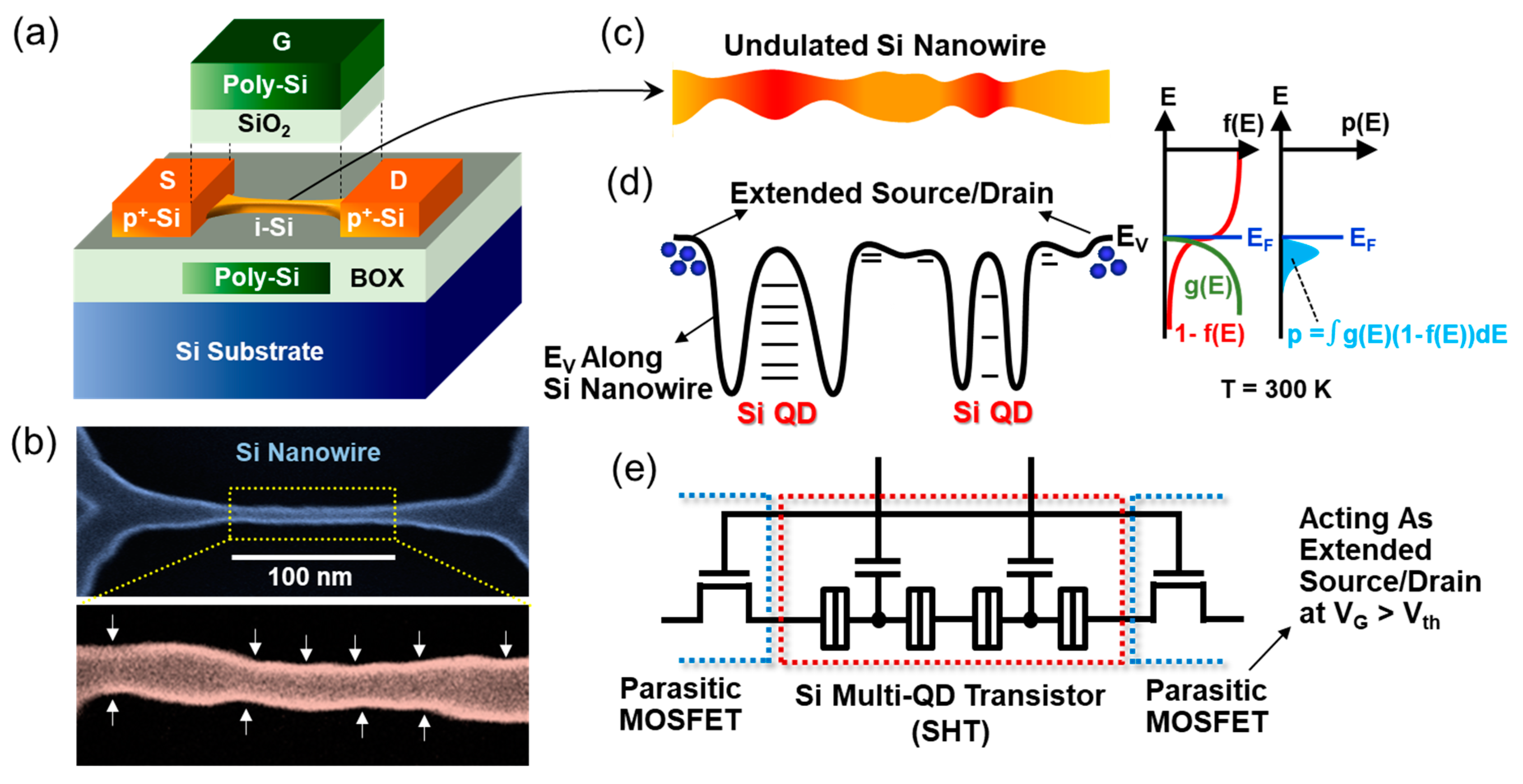
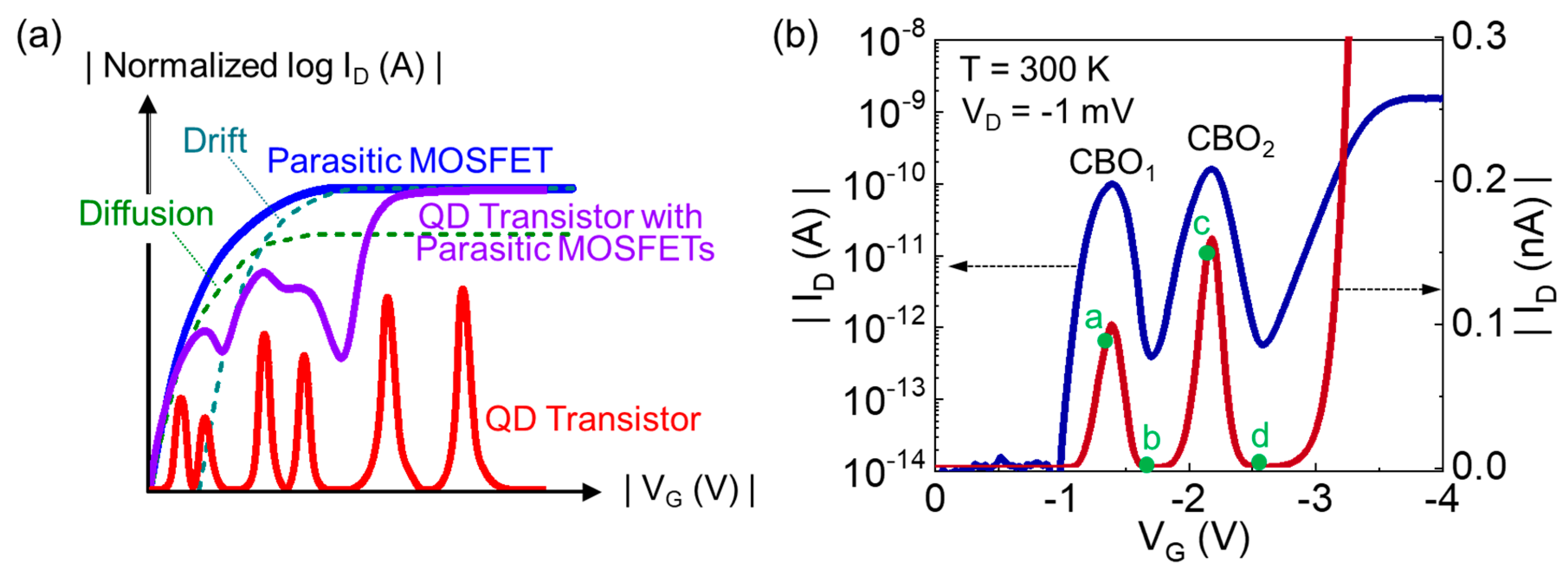
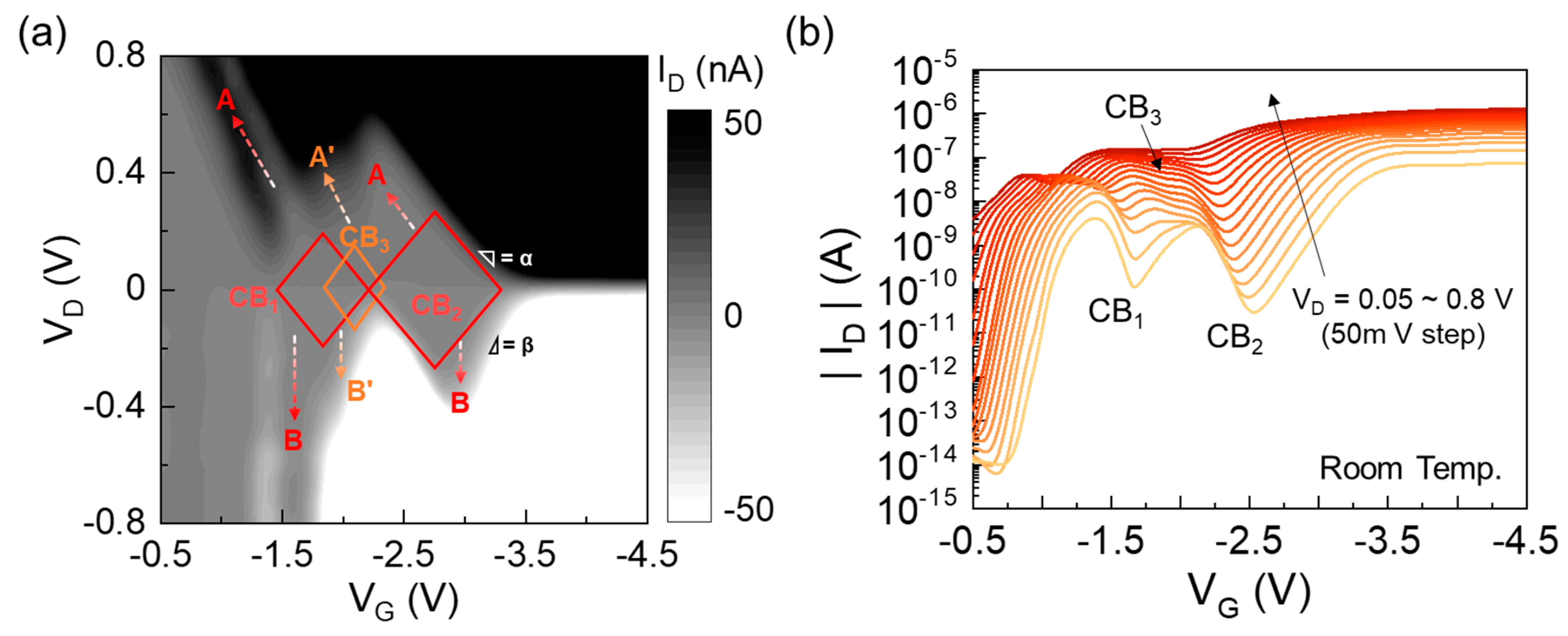
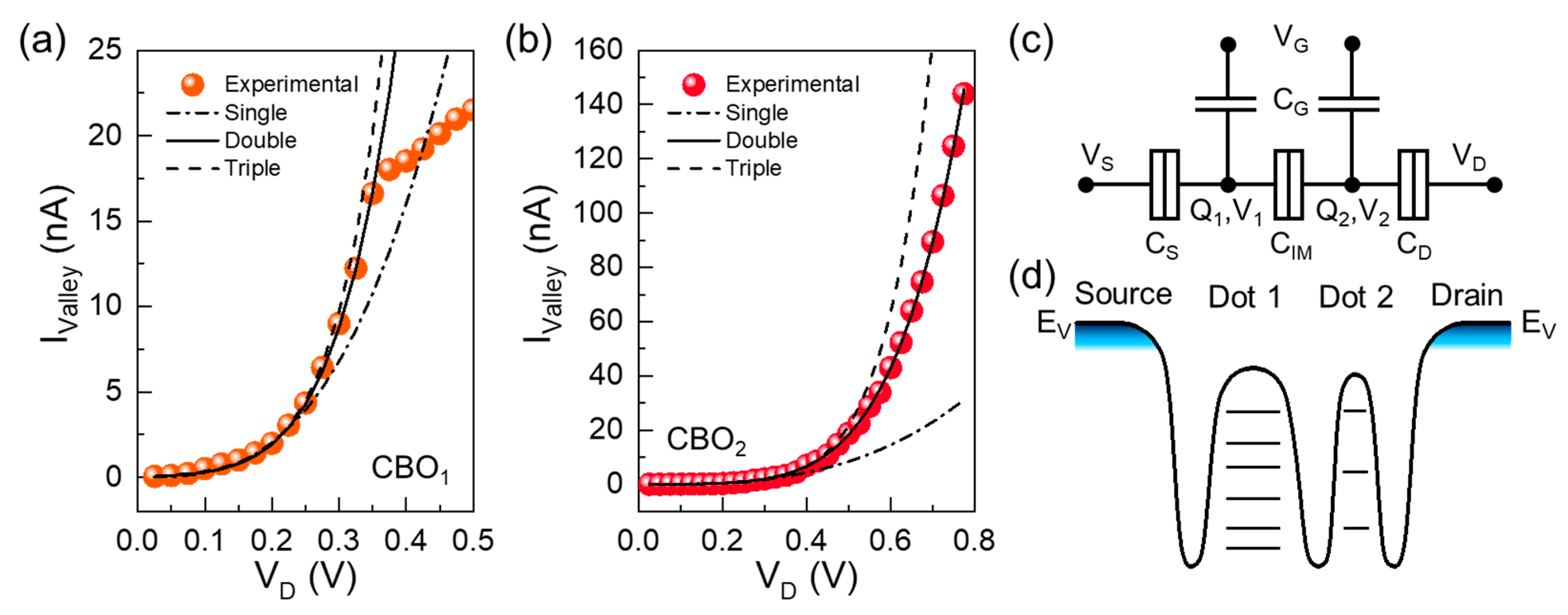
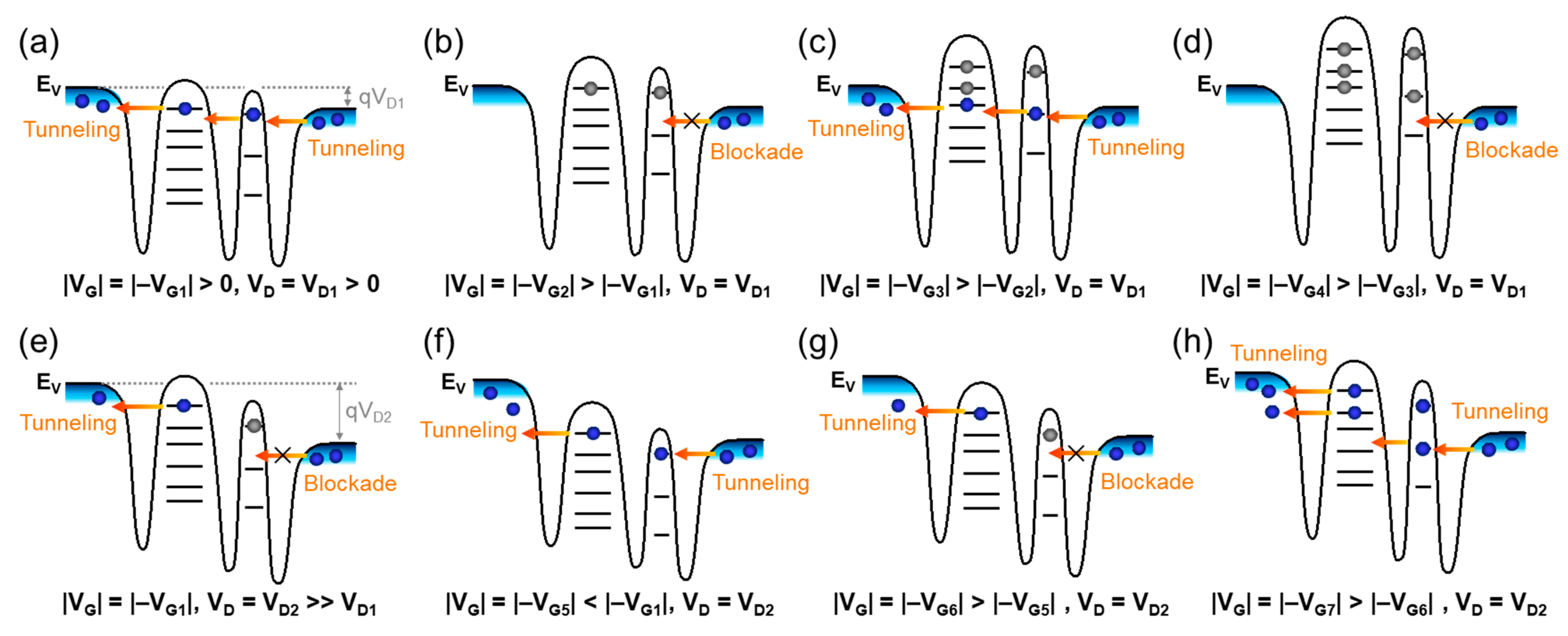
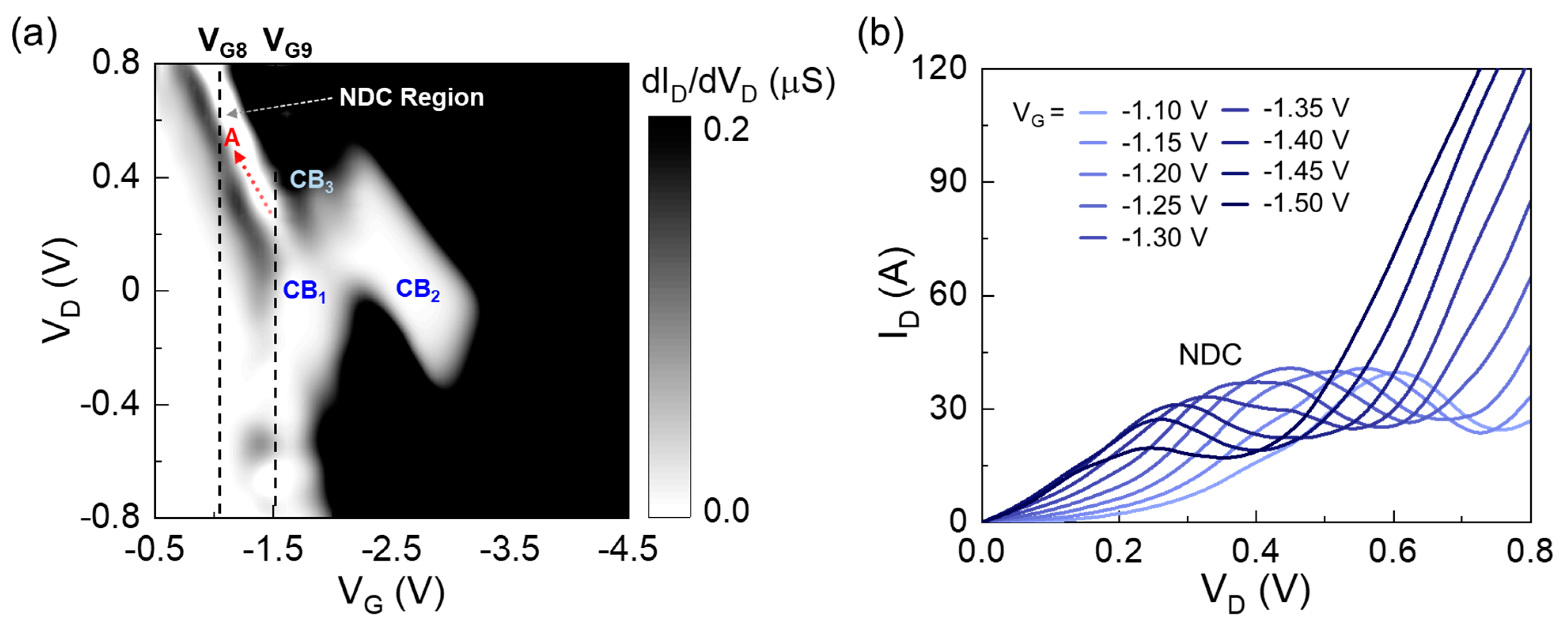
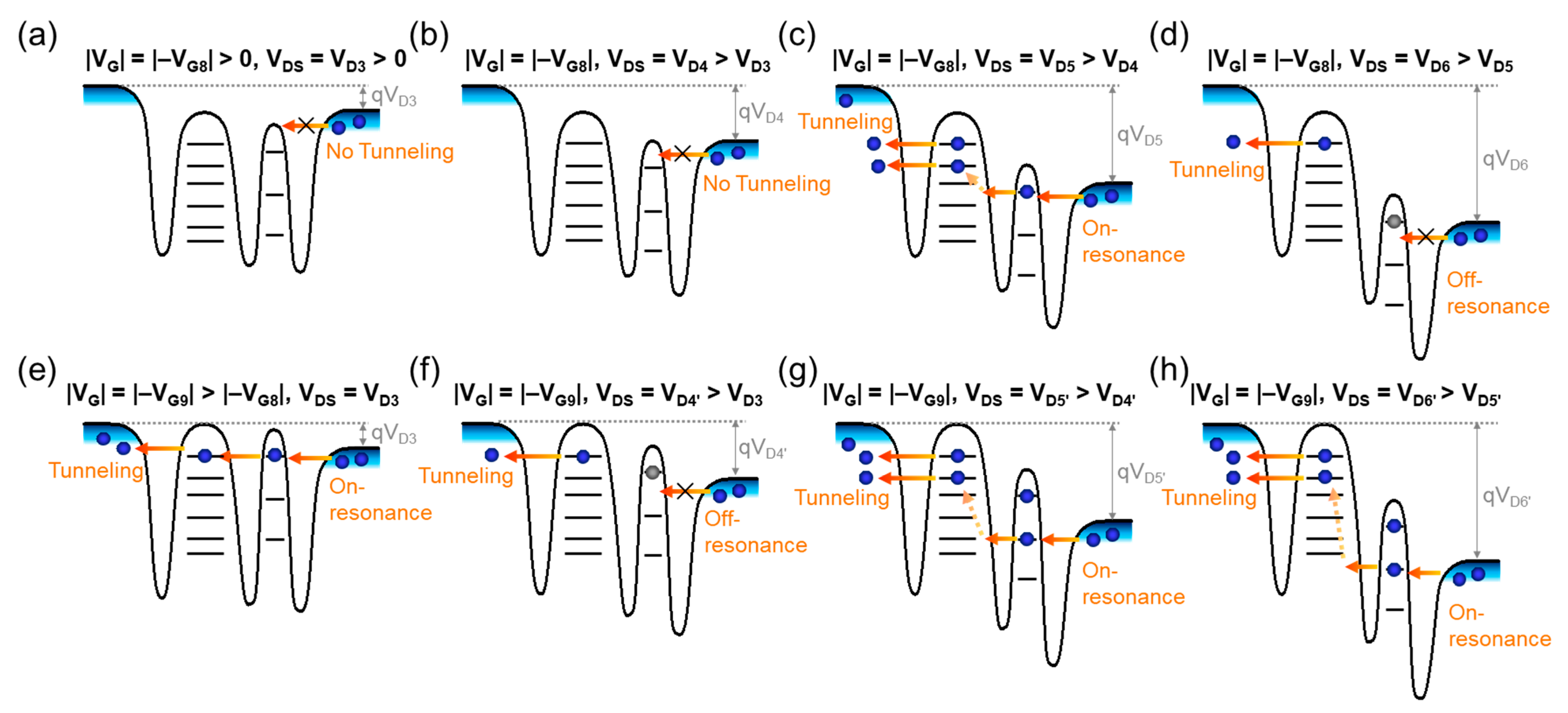
Disclaimer/Publisher’s Note: The statements, opinions and data contained in all publications are solely those of the individual author(s) and contributor(s) and not of MDPI and/or the editor(s). MDPI and/or the editor(s) disclaim responsibility for any injury to people or property resulting from any ideas, methods, instructions or products referred to in the content. |
© 2023 by the authors. Licensee MDPI, Basel, Switzerland. This article is an open access article distributed under the terms and conditions of the Creative Commons Attribution (CC BY) license (https://creativecommons.org/licenses/by/4.0/).
Share and Cite
Lee, Y.; Jun, H.; Park, S.; Kim, D.Y.; Lee, S. Transport Characteristics of Silicon Multi-Quantum-Dot Transistor Analyzed by Means of Experimental Parametrization Based on Single-Hole Tunneling Model. Nanomaterials 2023, 13, 1809. https://doi.org/10.3390/nano13111809
Lee Y, Jun H, Park S, Kim DY, Lee S. Transport Characteristics of Silicon Multi-Quantum-Dot Transistor Analyzed by Means of Experimental Parametrization Based on Single-Hole Tunneling Model. Nanomaterials. 2023; 13(11):1809. https://doi.org/10.3390/nano13111809
Chicago/Turabian StyleLee, Youngmin, Hyewon Jun, Seoyeon Park, Deuk Young Kim, and Sejoon Lee. 2023. "Transport Characteristics of Silicon Multi-Quantum-Dot Transistor Analyzed by Means of Experimental Parametrization Based on Single-Hole Tunneling Model" Nanomaterials 13, no. 11: 1809. https://doi.org/10.3390/nano13111809
APA StyleLee, Y., Jun, H., Park, S., Kim, D. Y., & Lee, S. (2023). Transport Characteristics of Silicon Multi-Quantum-Dot Transistor Analyzed by Means of Experimental Parametrization Based on Single-Hole Tunneling Model. Nanomaterials, 13(11), 1809. https://doi.org/10.3390/nano13111809






